Maytag W10740630B, W10740631B - SP User Manual

TOP-LOADING |
LAVEUSE À CHARGEMENT |
WASHER |
PAR LE DESSUS |
USE AND CARE GUIDE |
GUIDE D’UTILISATION ET |
|
D’ENTRETIEN |
Para una versión de estas instrucciones en español, visite www.maytag.com
Table of Contents |
Table des matières |
WASHER SAFETY..................................................................... |
2 |
WHAT’S NEW UNDER THE LID?............................................. |
3 |
CONTROL PANEL AND FEATURES........................................ |
4 |
CYCLE GUIDE........................................................................... |
6 |
USING YOUR WASHER............................................................ |
7 |
WASHER MAINTENANCE...................................................... |
10 |
TROUBLESHOOTING............................................................. |
12 |
WARRANTY............................................................................ |
16 |
ASSISTANCE OR SERVICE................................ |
BACK COVER |
SÉCURITÉ DE LA LAVEUSE.................................................. |
|
17 |
QUOI DE NEUF SOUS LE COUVERCLE?............................. |
18 |
|
TABLEAU DE COMMANDE ET |
|
|
CARACTÉRISTIQUES............................................................ |
|
19 |
GUIDE DE PROGRAMMES.................................................... |
|
21 |
UTILISATION DE LA LAVEUSE.............................................. |
|
22 |
ENTRETIEN DE LA LAVEUSE................................................ |
|
25 |
DÉPANNAGE........................................................................... |
|
27 |
GARANTIE............................................................................... |
|
34 |
ASSISTANCE OU SERVICE............. |
COUVERTURE ARRIÈRE |
|
Designed to use only
HE High Efficiency detergents.
Conçue pour l’utilisation d’un détergent haute efficacité seulement.
W10740630B W10740631B - SP
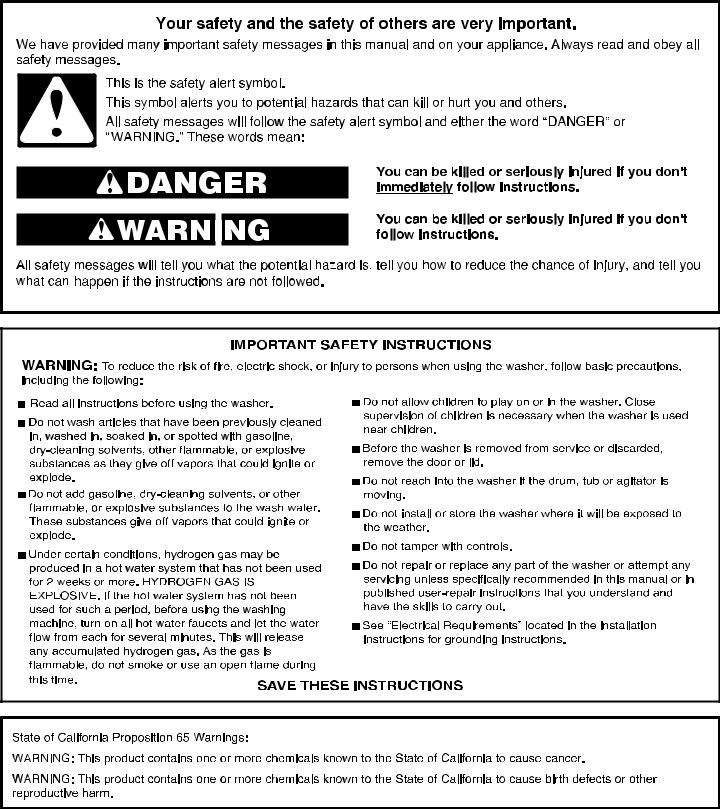
WASHER SAFETY
2

WHAT’S NEW UNDER THE LID?
Your new washer will operate differently than your past agitator-style washer.
Lid Lock
To allow for higher spin speeds, the lid will lock and the Lid Locked light will turn on. When lit, the lid is locked and cannot be opened. When off, the lid can be opened. After a cycle is started, water will enter the washer. Lid will be unlocked during the Sensing Fill and Wash process. If you need to open the lid to add a garment after this point, you must press START/Pause and wait for the lid to unlock. The lid will only unlock after washer movement has stopped. It may take several seconds to several minutes for the lid to unlock. Press START/Pause to resume the cycle.
 Sounds
Sounds
At different stages of the wash cycle, you may hear sounds and pauses different from those of your previous washer. For example, you may hear a clicking and hum at the beginning of the cycle as the lid lock goes through a selftest. There will be different kinds of humming and whirring sounds as the agitator tests for load balance or moves
the load. Sometimes, you may hear nothing at all as the washer allows time for clothes to soak.
 Automatic Load Size Sensing
Automatic Load Size Sensing
Once you start the cycle, the washer will fill to the water level. When the washer is done filling, it will start to agitate after it determines the correct level for the load. The washer will then fill to the appropriate water level based on the load size.
This low-water wash method uses less water and energy compared to a traditional agitator-style washer.
IMPORTANT:
■■ After the washer basket fills to the selected water level, the lid must be closed before the wash cycle can start. If filling stops with the lid open, close lid and press START/Pause button.
3
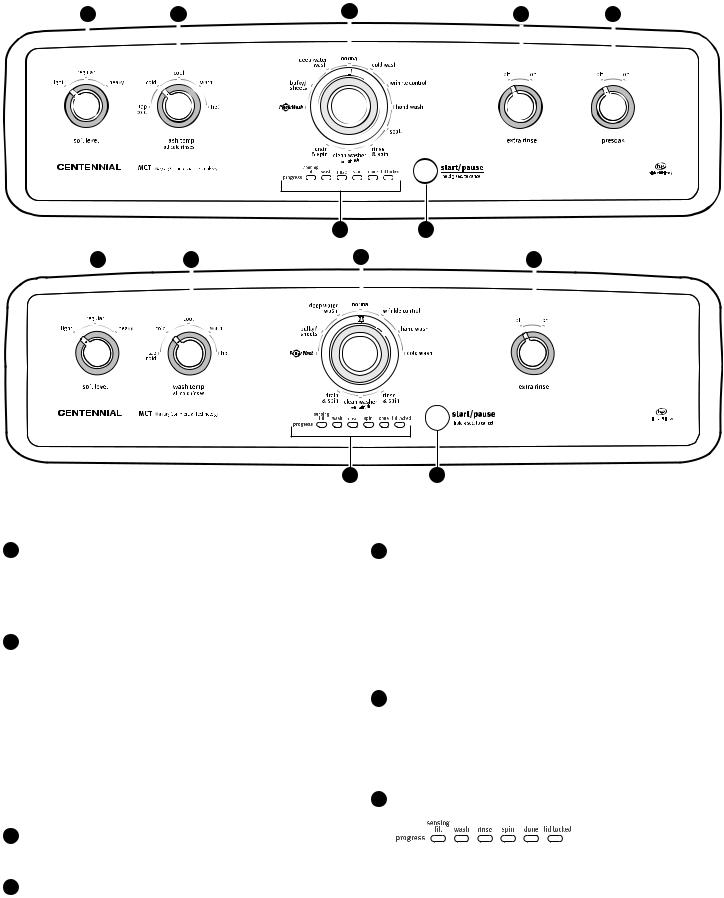
CONTROL PANEL AND FEATURES
1 |
2 |
3 |
4 |
5 |
|||||||||||
|
|
|
|
|
|
|
|
|
|
|
|
|
|
|
|
|
|
|
|
|
|
|
|
|
|
|
|
|
|
|
|
|
|
|
|
|
|
|
|
|
|
|
|
|
|
|
|
|
|
|
|
|
|
|
|
|
|
|
|
|
|
|
|
|
|
|
|
|
|
|
|
|
|
|
|
|
|
|
|
|
|
|
|
|
|
|
|
|
|
|
|
|
|
|
|
|
|
|
|
|
|
|
|
|
|
|
|
|
|
|
|
|
|
|
|
|
|
|
|
|
|
|
|
|
|
|
|
7 6
1 |
|
2 |
3 |
|
4 |
|||||
|
|
|
|
|
|
|
|
|
|
|
|
|
|
|
|
|
|
|
|
|
|
|
|
|
|
|
|
|
|
|
|
|
|
|
|
|
|
|
|
|
|
|
|
|
|
|
|
|
|
|
|
|
|
|
|
|
|
|
|
|
|
|
|
|
|
|
|
|
|
|
|
|
|
|
|
|
7 6
Not all features and options are available on all models.
Appearance may vary.
1SOIL LEVEL
Select the setting most suitable for your load. For heavily soiled and sturdy fabrics, select Heavy Soil Level for more wash time. For lightly soiled and delicate fabrics, select Light Soil Level for less wash time. A lighter soil-level setting will help reduce tangling and wrinkling.
2WASH TEMP
Temperature senses and maintains uniform water temperatures by regulating incoming hot and cold water.
Select a wash temperature based on the type of fabric and soils being washed. For best results and following the garment label instructions, use the warmest wash water safe for your fabric.
■■ On some models and cycles, warm and hot water may be cooler than your previous washer.
■■ Even in a cold and cool water wash, some warm water may be added to the washer to maintain a minimum temperature.
3WASH CYCLE KNOB
Use the Wash Cycle knob to select cycles on your washer. See “Cycle Guide” for detailed descriptions of cycles.
4EXTRA RINSE
This option can be used to automatically add a second rinse to most cycles.
5PRESOAK (Depending on Model)
Use this option to add an extra soak period to any cycle when washing heavily soiled garments. This option will alternate between a soak and a gentle agitation.
NOTE: If your washer does not have a presoak/soak option or cycle, press the Start/Pause button to pause the cycle after the washer has filled with water. When you have soaked your items for the desired amount of time, press the Start/ Pause button again to continue the cycle.
6START/PAUSE BUTTON
Press to start the selected cycle; press again to pause the cycle and unlock the lid.
NOTE: If the washer is spinning, it may take several minutes to unlock the lid. Press and hold for 3 seconds to cancel a cycle.
7PROGRESS LIGHTS
The Progress Lights show the progress of a cycle.
At each stage of the process, you may notice sounds or pauses that are different from traditional washers.
4
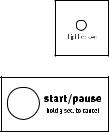
SENSING FILL
When the START/Pause button is pressed, the washer will fill to an initial water level and begin sensing to determine the load size. The washer will then continue filling to the appropriate water level based on load size and proceed to Wash.
If the lid is opened or the START/Pause button is pressed, the cycle will pause. Closing the lid and/ or pressing the START/Pause button will resume the
cycle. If the cycle remains paused with the lid open for 10 minutes, the washer will pump out the water.
WASH
You will hear the agitator moving the load. The motor sounds may change at different stages in the cycle. Wash time is determined by the selected soil level.
RINSE
You will hear sounds similar to the wash cycle as the washer rinses and moves the load. You may hear the motor turning on briefly (short hum) to move the
basket while filling.
SPIN
The washer spins the load at increasing speeds for proper water removal based on the selected cycle.
DONE
Once the cycle is complete, this light will come on. For best results, remove the load promptly.
LID LOCKED
The Lid Lock feature allows for higher spin speeds. When the Lid Locked light is lit, the
lid is locked and cannot be opened without pausing the cycle.When the Lid Locked light
is off, the lid can be opened.
To open the lid after it has been
locked, press START/Pause. The
lid will unlock once the washer movement has stopped. This may
take several minutes if the load
was spinning at high speed. Press START/Pause while the lid is closed to resume the cycle.
5

CYCLE GUIDE
For best fabric care, choose the cycle that best fits the load being washed.
Recommended settings for best performance in bold.
Not all cycles and options are available on all models.
Items to wash: |
Cycle: |
Wash Temp*: |
Spin |
Cycle Details: |
|
|
|
Speed: |
|
|
|
|
|
|
Sturdy fabrics, |
Power |
Hot |
High |
Use this cycle for heavily soiled or sturdy items. Water-level |
colorfast items, |
Wash® |
Warm |
|
sensing process may take longer for some items than for |
towels, jeans |
|
Cool |
|
others because they will absorb more water than other fabric |
|
|
Cold |
|
types. |
|
|
Tap Cold |
|
|
Large items such as |
Bulky/ |
Hot |
High |
Use this cycle to wash large items. The washer will fill with |
sheets, sleeping bags, |
Sheets |
Warm |
|
enough water to wet down the load before the wash portion |
small comforters, |
|
Cool |
|
of the cycle begins. This cycle uses a higher water level than |
jackets, small |
|
Cold |
|
other cycles. |
washable rugs |
|
Tap Cold |
|
|
Casual and mixed |
Deep Water |
Hot |
High |
Provides maximum wash time and action for tough stains |
loads, jeans, towels, |
Wash |
Warm |
|
and soils. Use this cycle for heavily soiled or sturdy items. |
sturdy fabrics |
|
Cool |
|
Water-level sensing process may take longer for some items |
|
|
Cold |
|
than for others because they will absorb more water than |
|
|
Tap Cold |
|
other fabric types. |
Cottons, linens, and |
Normal |
Hot |
High |
Use this cycle for normally or lightly soiled cottons and |
mixed-garment loads |
|
Warm |
|
mixed-fabric loads. |
|
|
Cool |
|
|
|
|
Cold |
|
|
|
|
Tap Cold |
|
|
No-iron fabrics, |
Wrinkle |
Hot |
Low |
Use this cycle to wash loads of no-iron fabrics such as sport |
cottons, perm press, |
Control |
Warm |
|
shirts, blouses, casual business clothes, permanent press, |
linens, synthetics |
|
Cool |
|
and blends. |
|
|
Cold |
|
|
|
|
Tap Cold |
|
|
Machine wash silks, |
Hand Wash |
Hot |
Low |
Use this cycle to wash lightly soiled garments indicating |
handwash fabrics |
|
Warm |
|
“Machine Washable Silks” or “Gentle” cycle on the care |
|
|
Cool |
|
label. Place small items in mesh garment bags before |
|
|
Cold |
|
washing. This cycle uses a higher, preset water level. |
|
|
Tap Cold |
|
|
Bright or darkly |
Cold Wash |
Cold |
High |
Cold water with an additional wash action gently lifts stains |
colored cottons, |
|
|
|
while caring for fabrics. Settings may be adjusted as desired |
linens, casual and |
|
|
|
but must use only cold water settings. |
mixed loads |
|
|
|
|
Swimsuits and items |
Rinse & |
Cold Rinse |
High |
Combines a rinse and high-speed spin for loads requiring |
requiring rinsing |
Spin |
Only |
|
an additional rinse cycle or to complete a load after power |
without detergent |
|
|
|
interruption. Also use for loads that require rinsing only. |
Hand-washed |
Drain & |
N/A |
High |
This cycle uses a spin to shorten drying times for heavy |
garments or dripping |
Spin |
|
|
fabrics or special-care items washed by hand. Use this cycle |
wet items |
|
|
|
to drain washer after cancelling a cycle or completing a cycle |
|
|
|
|
after a power failure. |
No clothes in washer |
Clean |
Hot |
Low |
Use this cycle every 30 washes to keep the inside of your |
|
Washer |
|
|
washer fresh and clean. This cycle uses a higher water level. |
|
with |
|
|
Use with affresh® Washer Cleaner tablet or liquid chlorine |
|
affresh® |
|
|
bleach to thoroughly clean the inside of your washer. This |
|
|
|
|
cycle should not be interrupted. See "Washer Care." |
|
|
|
|
IMPORTANT: Do not place garments or other items in the |
|
|
|
|
washer during this cycle. Use only with an empty wash tub. |
Heavily soiled fabrics |
Soak |
Hot |
No Spin |
Use this cycle to soak small spots of set-in stains on fabrics. |
|
|
Warm |
|
The washer will use intermittent agitation and soaking. At the |
|
|
Cool |
|
end of the cycle, water will drain but washer will not spin. |
|
|
Cold |
|
|
|
|
Tap Cold |
|
|
*All rinses are cold. |
|
|
|
|
6

USING YOUR WASHER
1. Sort and prepare your laundry |
2. Add laundry products |
•Empty pockets. Loose change, buttons, or any small object can pass under the agitator and become trapped, causing unexpected sounds.
•Sort items by recommended cycle, water temperature, and colorfastness.
•Separate heavily soiled items from lightly soiled items.
•Separate delicate items from sturdy fabrics.
•Do not dry garments if stains remain after washing because heat can set stains into fabric.
•Treat stains promptly.
•Close zippers, fasten hooks, tie strings and sashes, and remove non-washable trim and ornaments.
•Mend rips and tears to avoid further damage to items during washing.
Helpful Tips:
•When washing water-proof or water-resistant items, load evenly.
•Use mesh garment bags to help avoid tangling when washing delicate or small items.
•Turn knits inside out to avoid pilling. Separate lint-takers from lint-givers. Synthetics, knits, and corduroy fabrics will pick up lint from towels, rugs, and chenille fabrics.
NOTE: Always read and follow fabric care label instructions to avoid damage to your garments.
Add a measured of amount of HE detergent or single-dose laundry packet into the basket.
If using Oxi-type boosters, color-safe bleach, or fabric softener crystals, add to the bottom of the washer basket before adding clothes.
IMPORTANT: Use only High Efficiency detergents. The package will be marked “HE” or “High Efficiency.” Lowwater washing creates excessive sudsing with a regular non-HE detergent. Using regular detergent will likely result in longer cycle times and reduced rinsing performance. It may also result in component failures and noticeable mold or mildew. HE detergents are made to produce the right amount of suds for the best performance.
NOTE: Follow the manufacturer’s instructions to determine the amount of laundry products to use.
7
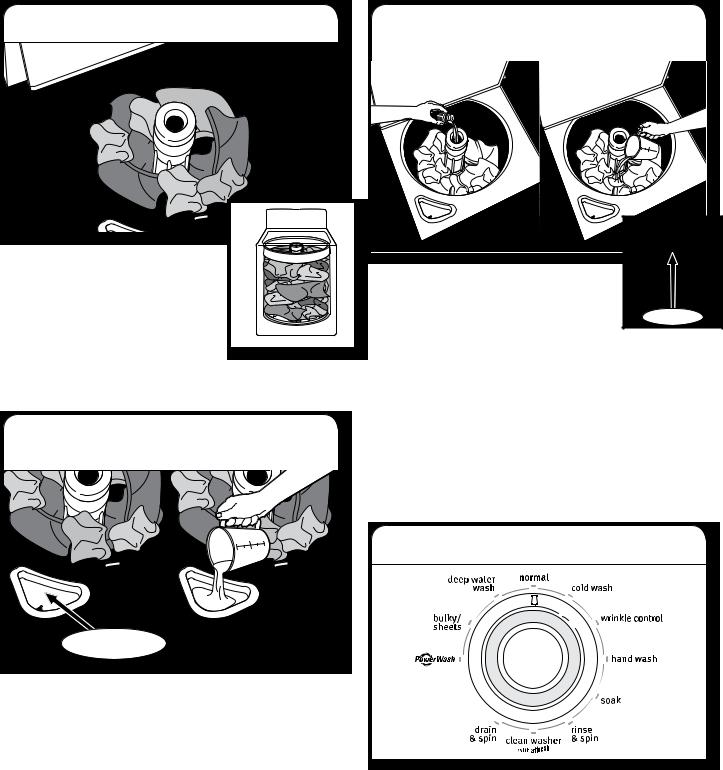
3. Load laundry into washer |
5. Add fabric softener to dispenser |
|
(on some models) |
Load garments in loose heaps evenly around basket wall. For best results, do not pack the load tightly. Do not wrap large items such as sheets around the agitator; load them in loose piles around the sides of the basket. Try mixing different-sized items to reduce tangling.
IMPORTANT: Do not tightly pack or
force items into washer. Items need to move freely for best cleaning and to reduce wrinkling and tangling.
4. Add liquid chlorine bleach to dispenser
Liquid
Chlorine Bleach
Do not overfill, dilute, or use more than 1 cup (250 mL). Do not use color-safe bleach or Oxi products in the same cycle with liquid chlorine bleach.
Pour a measured amount of liquid fabric |
|
softener into dispenser; always follow |
|
manufacturer’s directions for correct amount |
|
of fabric softener based on your load size. |
MAX FILL |
Dilute liquid fabric softener by filling the dispenser with warm water until liquid reaches the underside of the rim. See max fill line arrows.
IMPORTANT: Fabric Softener will dispense during the final rinse portion of the cycle.
Adding Liquid Fabric Softener Manually to Wash Load
During the final rinse, wait until the washer has completed filling, press the START/Pause button to pause the washer. Lift the lid and add the measured recommended amount of liquid fabric softener. Do not use more than the recommended amount. Close the lid and press the START/Pause button again to start the washer.
6. Select cycle
Turn cycle knob to choose your wash cycle. For more information, see “Cycle Guide.”
8
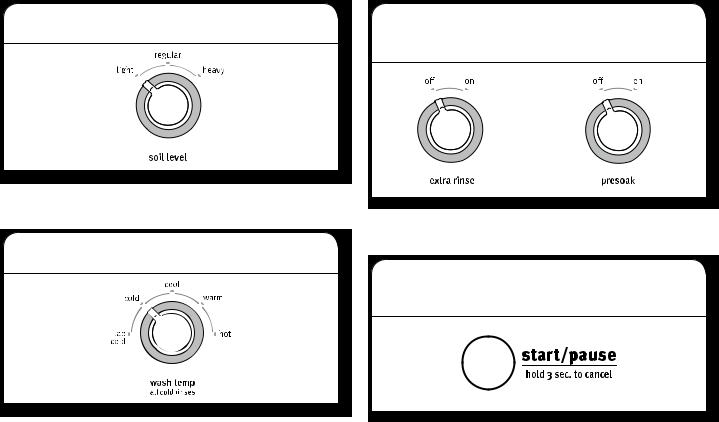
7. Select SOIL LEVEL
Once you select a cycle, select the desired soil level by turning the Soil Level knob to the appropriate setting.
8. Select WASH TEMP
Once you select a cycle, select the desired wash temperature by turning the Wash Temperature knob to the appropriate setting based on your load. All rinses are cold.
NOTE: Always read and follow fabric care label instructions to avoid damage to your garments.
Wash Temp |
Suggested Fabrics |
|
|
|
|
Hot |
|
|
Some cold water is added to save |
Whites and pastels |
|
energy. This will be cooler than your |
Durable garments |
|
hot water heater setting. |
||
Heavy soils |
||
|
||
|
|
|
Warm |
|
|
Some cold water will be added, so |
Bright colors |
|
this will be cooler than what your |
Moderate to light |
|
previous washer provided. |
||
soils |
||
|
||
|
|
|
Cool |
|
|
Warm water is added to assist in |
Colors that bleed |
|
soil removal and to help dissolve |
or fade |
|
detergents. |
Light soils |
|
|
||
|
|
|
Cold |
|
|
Warm water may be added to assist |
Dark colors that |
|
in soil removal and to help dissolve |
bleed or fade |
|
detergents. |
Light soils |
|
|
||
|
|
|
Tap Cold |
|
|
This is the temperature from |
Dark colors that |
|
your faucet. |
bleed or fade |
|
|
Light soils |
|
|
|
9. Select cycle options (on some models)
Select the desired cycle options.
10. Press START/Pause to begin wash cycle
Press the START/Pause button to start the wash cycle. When the cycle has finished, the Done indicator will light. Promptly remove garments after cycle has completed to avoid odor, reduce wrinkling, and prevent rusting of metal hooks, zippers, and snaps.
Unlocking the Lid to Add Garments:
If you need to open the lid to add 1 or 2 missed garments:
Press START/Pause. The lid will unlock once the washer movement has stopped. This may take several minutes if the load was spinning at high speed. Add garments, close lid, and press START/Pause again to restart the cycle.
If lid is left open for more than 10 minutes, the water will pump out automatically.
9
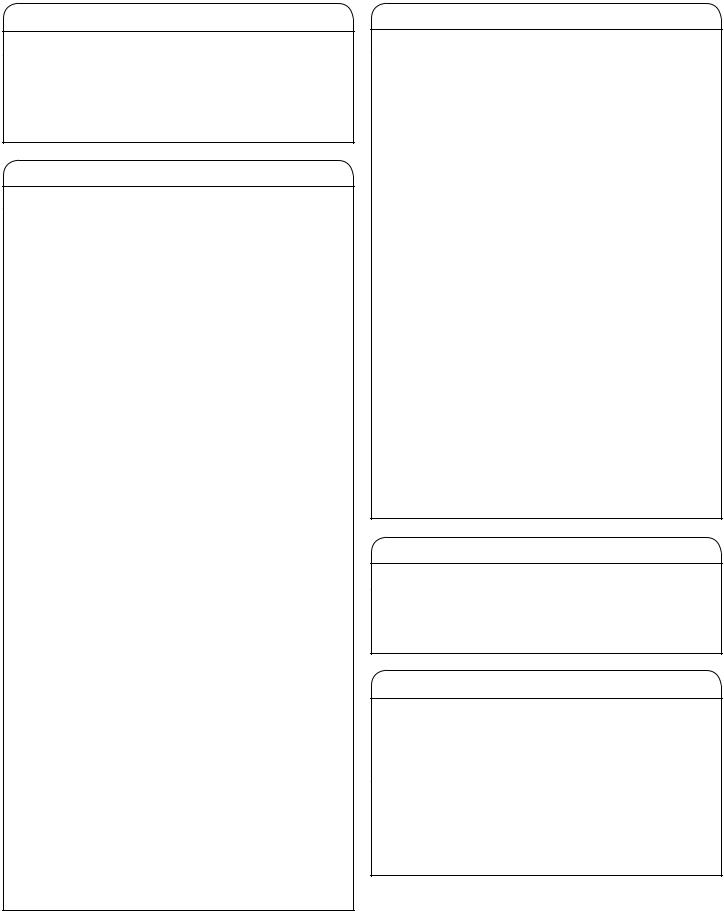
WASHER MAINTENANCE
WATER INLET HOSES
Replace inlet hoses after 5 years of use to reduce the risk of hose failure. Periodically inspect and replace inlet hoses if bulges, kinks, cuts, wear, or leaks are found.
When replacing your inlet hoses, mark the date of replacement on the label with a permanent marker.
NOTE: This washer does not include inlet hoses. See the “Installation Instructions” for more information.
WASHER CARE
Recommendations to Help Keep Your Washer Clean and Performing at its Best
1.Always follow the detergent manufacturer’s instructions regarding the amount of detergent to use. Never use more than the recommended amount because that may increase the rate at which detergent and soil residue accumulate inside your washer, which in turn may result in undesirable odor.
2.Use warm and hot wash water settings sometimes (not exclusively cold water washes) because they do a better job of controlling the rate at which soils and detergent accumulate.
3.Always leave the washer lid open between uses to help
dry out the washer and prevent the buildup of odor-causing residue.
Cleaning Your Top Loading Washer
Read these instructions completely before beginning the routine cleaning processes recommended below. This Washer Maintenance Procedure should be performed, at a minimum, once per month or every 30 wash cycles, whichever occurs sooner, to control the rate at which soils and detergent may otherwise accumulate in your washer.
Cleaning the Inside of the Washer
To keep your washer odor-free, follow the usage instructions provided above, and use this recommended monthly cleaning procedure:
Recommended Cycle for Cleaning the Washer
Refer to the “Cycle Guide” for the optimal cycle for cleaning the inside of the washer. Use this cycle with affresh® Washer Cleaner or liquid chlorine bleach as described below.
Begin Procedure
1.affresh® Washer Cleaner cycle procedure (recommended for best performance):
a.Open the washer lid and remove any clothing or items.
b.Place an affresh® Washer Cleaner tablet in the bottom of the washer basket.
c.Do not place an affresh® Washer Cleaner tablet in the detergent dispenser.
d.Do not add any detergent or other chemical to the washer when following this procedure.
e.Close the washer lid.
f.Select the cycle recommended for cleaning the inside of the washer.
g.Press the START/Pause button to start the cycle.
NOTE: For best results, do not interrupt cycle. If cycle must be interrupted, press START/Pause once or twice (depending on model). After the cycle has stopped, run a Rinse & Spin cycle to rinse cleaner from washer.(depending on model). After the cycle has stopped, run a Rinse & Spin cycle to rinse cleaner from washer.
WASHER CARE (cont.)
2.Chlorine Bleach Procedure (Alternative):
a.Open the washer lid and remove any clothing or items.
b.Add 1 cup (236 mL) of liquid chlorine bleach to the bleach compartment.
NOTE: Use of more liquid chlorine bleach than is recommended above could cause washer damage over time.
c.Close the washer lid.
d.Do not add any detergent or other chemical to the washer when following this procedure.
e.Select the cycle recommended for cleaning the inside of the washer.
f.Press the START/Pause button to start the cycle.
NOTE: For best results, do not interrupt cycle. If cycle must be interrupted, press START/Pause once or twice (depending on model). After the cycle has stopped, run a Rinse & Spin cycle to rinse cleaner from washer.
Cleaning the Dispensers
After a period of using your washer, you may find some residue buildup in the washer’s dispensers. To remove residue from the dispensers, wipe them with a damp cloth and towel dry. Do not attempt to remove the dispensers or trim for cleaning. The dispensers and trim are not removable. If your model has a dispenser drawer, however, remove the drawer and clean
it before or after you run the Clean Washer cycle. Use an allpurpose surface cleaner, if needed.
Cleaning the Outside of the Washer
Use a soft, damp cloth or sponge to wipe away any spills. Use only mild soaps or cleaners when cleaning external washer surfaces.
IMPORTANT: To avoid damaging the washer’s finish, do not use abrasive products.
NON-USE AND VACATION CARE
Operate your washer only when you are home. If moving or not using your washer for a period of time, follow these steps:
1.Unplug or disconnect power to washer.
2.Turn off water supply to washer to avoid flooding due to water-pressure surge.
WINTER STORAGE CARE
IMPORTANT: To avoid damage, install and store washer where it will not freeze. Because some water may stay in hoses, freezing can damage washer. If storing or moving during freezing weather, winterize your washer.
To winterize washer:
1.Shut off both water faucets Disconnect and drain waterinlet hoses.
2.Put 1 qt. (1 L) of R.V.-type antifreeze in basket and run washer on Rinse & Spin cycle for about 30 seconds to mix antifreeze and remaining water.
3.Unplug washer or disconnect power.
10

TRANSPORTING YOUR WASHER
1.Shut off both water faucets. Disconnect and drain water inlet hoses.
2.If washer will be moved during freezing weather, follow "Winter Storage Care" directions before moving.
3.Disconnect drain from drain system and drain any remaining water into a pan or bucket. Disconnect drain hose from back of washer.
4.Unplug power cord.
5.Place inlet hoses and drain hose inside washer basket.
6.Drape power cord over edge and into washer basket.
7.Place packing tray from original shipping materials back inside washer. If you do not have packing tray, place heavy blankets or towels into basket opening. Close lid and place tape over lid and down front of washer. Keep lid taped until washer is placed in new location. Transport washer in upright position.
REINSTALLING/USING WASHER AGAIN
To reinstall washer after non-use, vacation, winter storage, or moving:
1.Refer to "Installation Instructions" to locate, level, and connect washer.
2.Before using again, run washer through the following recommended procedure:
To use washer again:
1.Flush water pipes and hoses. Reconnect water-inlet hoses. Turn on both water faucets.
2.Plug in washer or reconnect power.
3.Run washer through Normal cycle to clean washer and remove antifreeze if used. Use half the manufacturer’s recommended amount of detergent for a medium-size load.
11
